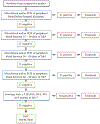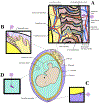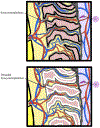Epidemiology and pathogenesis of maternal-fetal transmission of Trypanosoma cruzi and a case for vaccine development against congenital Chagas disease
- PMID: 31678160
- PMCID: PMC6954953
- DOI: 10.1016/j.bbadis.2019.165591
Epidemiology and pathogenesis of maternal-fetal transmission of Trypanosoma cruzi and a case for vaccine development against congenital Chagas disease
Abstract
Trypanos o ma cruzi (T. cruzi or Tc) is the causative agent of Chagas disease (CD). It is common for patients to suffer from non-specific symptoms or be clinically asymptomatic with acute and chronic conditions acquired through various routes of transmission. The expecting women and their fetuses are vulnerable to congenital transmission of Tc. Pregnant women face formidable health challenges because the frontline antiparasitic drugs, benznidazole and nifurtimox, are contraindicated during pregnancy. However, it is worthwhile to highlight that newborns can be cured if they are diagnosed and given treatment in a timely manner. In this review, we discuss the pathogenesis of maternal-fetal transmission of Tc and provide a justification for the investment in the development of vaccines against congenital CD.
Keywords: Chagas; Congenital; Maternal-fetal transmission; Trypanosoma cruzi; Vaccine.
Copyright © 2019 Elsevier B.V. All rights reserved.
Figures






References
-
- World Health Organization, Chagas disease in Latin America: an epidemiological update based on 2010 estimates, 2015. https://www.who.int/wer/2015/wer9006.pdf?ua=1. (Accessed 9/1/2019). - PubMed
-
- Perez-Molina JA, Molina I, Chagas disease, Lancet 391(10115) (2018) 82–94. - PubMed
-
- Stanaway JD, Roth G, The burden of Chagas disease: estimates and challenges, Glob Heart 10(3) (2015) 139–44. - PubMed
Publication types
MeSH terms
Substances
Grants and funding
LinkOut - more resources
Full Text Sources
Medical

